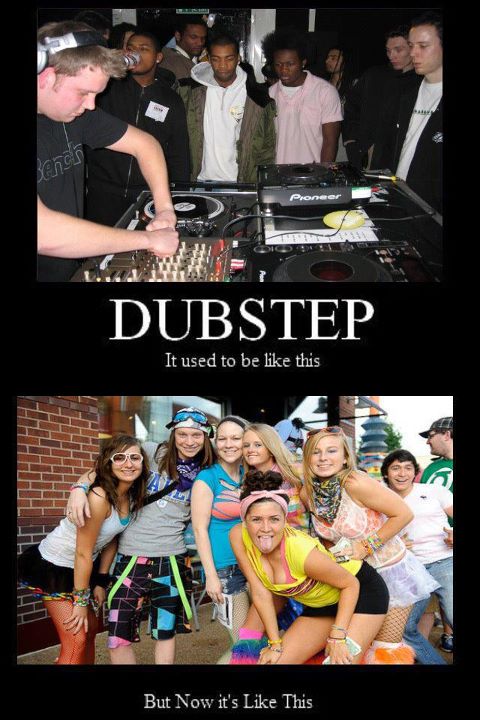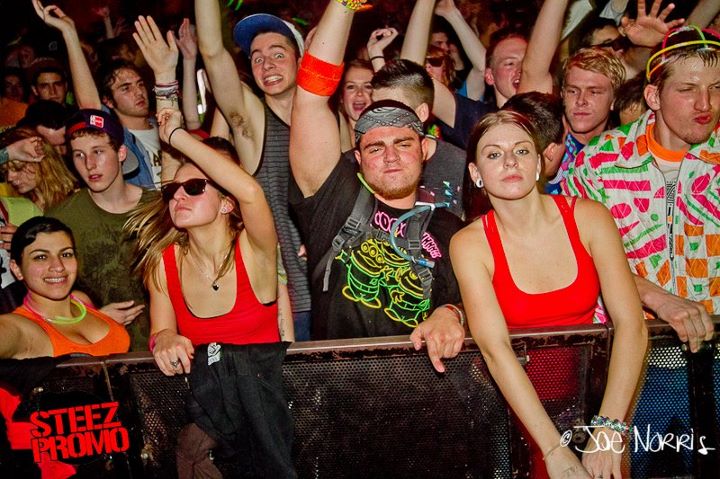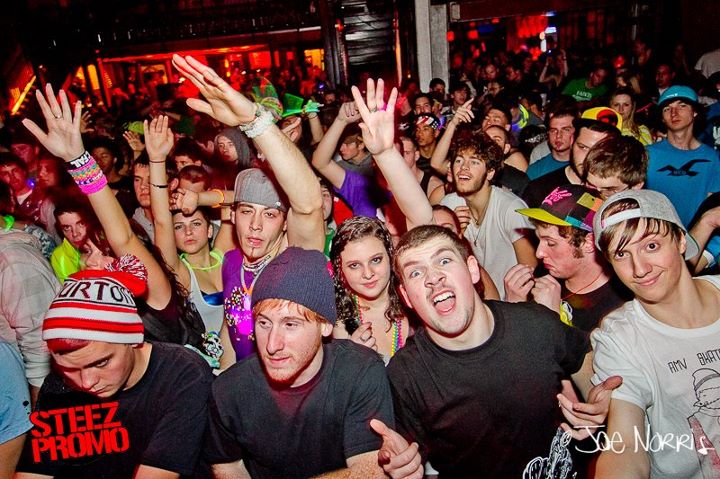
Below is the first of a two-part essay exploring the popularity of dubstep, a musical genre formerly associated with the underground EDM (electronic dance music) scene.
Part 1
You may not be a fan of the wub-wub-wubbing musical genre known as dubstep, but it is increasingly taking center stage in American popular culture. For example, a recent NorthFace advertisement uses it while a snowboarder glides down a snowy mountainscape, Britney Spears and Rihanna have both incorporated some dubstep into their recent work, teen heartthrob Justin Bieber is rumored to be working on his own dubstep album, and the teaser trailer for the new Mission Impossible film features a distinct wub-wubbing in the background. So what is dubstep anyway? And where did it come from?
Dubstep Goes to College
Dubstep was conceived in the London dance music scene in the late 90s and early 00s. It takes mainly from drum and bass and grime genres, but is influenced by many different styles of music, including dancehall and hip-hop. The heavy influence of grime, the dark elements of drum and bass and the guttural bass lines give it an almost dirty sound. This along with the layer of synthesizers are what people in the scene refer to when they describe the music (or party) as “grimey.”
Dubstep entered the mainstream club scene in 2006 in great part with the release of producer Oliver Jones’ (aka Skream) debut album “Skream,” which took club culture by storm in Europe (Woolliams 2008). The album also became widely popular in the United States EDM (electronic dance music) scene. MusicCritic did not miss to write a review on the album. It was a very steady climb since that point and everyone is wondering what the genre is.

The EDM scene itself has grown increasingly popular in the United States, although not in the same magnitude as in London or other European cities. However, with dubstep’s increasing popularity this may soon change dramatically. Dubstep’s growing popularity seems to be the greatest among college students, especially fraternities, who have helped popularize the musical genre across college campuses in the US. This is because dubstep lends itself nicely to inebriated frat parties: one can dance or drone off to it’s characteristic throbbing bass in between shotguning beers and bouts of competitive fist-bumping.
The aggressive, wobbling bassline of dubstep, as well as its spectacular use of crazy robot “noises” translates quite seamlessly to the rambunctious college party scene. Cultural producers like MTV have certainly taken quick notice of this and are ready to market, what core members of the EDM subculture have disdainfully labeled as “brostep,” to these new consumers. Brostep incorporates a massive amount of the characteristic wobbling bass, which is exemplified in the latest work of DJs like Skrillex, Rusko, Caspa, and Borgore.

Steez promo is a good example of the use of marketing to target the mainstream college demographic. As a production company that started with underground raves and parties in downtown Baltimore, Steez Promo became a hit within the fledgling EDM subculture in the mid-late 2000s. Their early parties were thrown at band practice spaces and warehouses for $10, where you could bring in a 40 oz. or a handle of Bourbon to hang out with friends and dance the night away. In those days you could see dubstep artists like Rusko (who now collaborates with the likes of Britney Spears, Rihanna, and T.I.) in a small, cramped, non-descript space. It was still very much an underground scene.
Steez Promo, quickly realizing the growing popularity of dubstep in popular music, began to flyer college campuses like Towson University and University of Maryland. They seized the opportunity to tap into this burgeoning marketplace niche, and began throwing monthly parties at an expensive venue, Bourbon St., and expanding to Philly and then DC, where the average ticket for a show is now $25. The vibe of these shows, aptly named “Dub Nation,” is, of course, quite different from the dance parties they started with, and which are still thrown by grassroots promoters in the underground EDM scene.
The Rise of “Brostep”
The term “brostep” has been used to describe the most recent wave of popular dubstep music which gained notoriety through Best Buy, Audi, and BMW advertisements, as well as other forms of mass media exposure, and which also heavily relies on predictable rhythmic patterns obviating the need for melodic content. However, the addition of DJs who spin this type of dubstep and are “second adopters” (Postrel 2003) comes as a threat to earlier adopters of this musical genre, who have largely incorporated elements of the subculture into an overarching lifestyle project (Thornton 1996). Some of these “hardcore” members even describe EDM raves and parties as rituals of community engagement and togetherness, sites of Durkheimian effervescence and spiritual connectivity (Durkheim 1912).

The inclusion of new members is perceived as a threat to this established community order, especially since the new listeners don’t have a particular experience or ideology attached to the music. Dubstep has been abstracted from its context and a spectacle of sound has been produced in order to attract people who are not at the EDM events but are listening to the radio or their computer speakers.
As a veteran of the EDM scene and music producer himself, Dan Vibeage from Aligning Minds describes the nature of dubstep as being “more about the subtlety and the nuances between the drums, spacey atmospheres, and deep basslines.” He goes on to say,
It was music designed to be played on huge, bass heavy sound systems so that the sub bass could be re-produced and that’s how it was best experienced. A lot of the basslines were so deep that if you played them on, say, laptop speakers, you wouldn’t hear half of the music going on because the subs weren’t being reproduced. The subs are what make it ‘drop’ and create excitement, and depth and energy.
In sociological terms, this distinction between brostep and dubstep serves to divide second adopters from earlier adopters and those who identify as “core” members of the subculture (Chalmers and Arthur 2008). In this way, taste (Bourdieu 1984) comes to define one’s membership in the EDM community, with “brostep” pejoratively applied to those whose attraction to dubstep is linked to more recent artists like Skrillex or Borgore. For example, the audio track below reveals Rusko, arguably a forefather of the brostep subgenre, distancing himself from the genre.

Much like Thornton’s (1996) research on the London club scene in the early 90s, “brostep” can also serve as a moniker for “the mainstream,” the passive clients of the culture industry who do not have the refined tastes of the core subculturalist. In this way, the “brostep” label serves as a social distancing mechanism. Purists within the subculture thereby create ever more subtle distinctions in order to protect their field-dependent identities as consumers from the intrusion of new members (Arsel and Thompson 2010). This helps members of subcultural groups maintain a source of distinction from the mythologized mainstream (Thornton 1996).
However unlike Thornton’s (1996) study, where DJs themselves served as the “taste arbiters” of the community, setting the trends and helping to define the subculture’s subsequent development, in the case of “brostep” the perceived taste arbiters are mostly cultural producers and record companies, the petite bourgeoisie of the culture industry and the mass media (Featherstone 1991). In this sense, subcultural forms come to be seen as produced from afar (corporations, capitalism), rather than organic products of members of the subculture (because DJs are the creators of music, and music translates into subcultural capital in music subcultures [Thornton 1996]). To some members of the EDM community, the intrusion of brostep is a threat. Many fear their culture may be hijacked by outsiders, and some even abandon the genre altogether.
Dan Vibeage also recounts the role of Web 2.0 and new technologies in facilitating the development of brostep as a subgenre of dubstep. He states,
In 2006 we had a number of producers making this new sound with a focus on space and bass. Each producer had his own take on how to do it, but they were all making spacey, dark music for big big speakers. With a little help from the internet, the genre grew because it was so unique. But in growing, it also evolved.
The relaxed, dubby vibe got pushed aside to make way for more. More wobble, more sounds, more everything. Maximize to maximize. Along came crappy speakers. Radios, laptops and white earbuds. No point in making bass sounds for something that can’t play low frequencies. So we throw in a bunch of electronic “filth” sounds. Take the overtones of the wobble and make them the focus. Wobble noise. Wobble anything that can be heard on laptop speakers. The result? Something that sounds like dubstep, except they took out all the deep parts and replaced with immediately digestible ‘fast food’ sounds is how I would think of them.
Hence, [there is] a pretty big musical divide between dubstep (bass and space) and brostep (in your face) – a lot of the ‘depth’ is gone – but of course this is relative, it depends on what you like!
Part 2 will post next week! Stay tuned.

Comments 4
Phillip Horrack — December 30, 2011
"Dubstep has been abstracted from its context" was damn pretty accurate, but "a spectacle of sound has been produced in order to attract people who are not at the EDM events but are listening to the radio or their computer speakers" is somewhat off.
Dubstep was never really an EDM genre. Yes, it's electronic, and yes, it's dance music, but it's different. It was never "rave" music. Raves connote glowsticks, lightshows, scantily clad girls, etc. It was music that was listened to in dark, basements with no light but the light of the mixer and decks, with 30 people in them (but a massive sound system nonetheless). It was dead as soon as it became "EDM music".
DMZ (who I assume you know well, if you consider yourself even remotely knowledgeable on dubstep as they're the single most influential establishment in the genre's history) has had the "catchprase" "Meditate on bassweight" for many years. That's really what it's about.
It's more like this:
"a spectacle of sound has been produced in order to attract people to the EDM events and those who are listening to the radio or their computer speakers."
There's much more of a cultural divide besides just that. Dubstep was built on soundsystem culture, dubplate culture, and also pirate radio culture.
Dubplates ("dubplate specials", dubplate or dub for short) are unreleased tracks that a producer will produce (dubplates are specifically acetate records, but in modern times, CDs and mp3s are also considered dubplates) and distribute very sparingly to DJs or keep to themselves altogether. Typically, dubplates aren't given to more than 5 or 6 DJs. They're meant to be exclusive.
The reason behind this is because dubstep was made for a very certain type of atmosphere (the aforementioned, dark, basement vibe + a huge soundsystem). Well, the producers/DJs dont want people listening to these tracks in any other sort of atmosphere, so they only play at the venues with proper soundsystems.
The people will come to hear certain tracks, certain dubplates, and it is ensured that they will hear the tracks in an atmosphere worthy of the music.
Dubplate culture and soundsystem culture go hand in hand.
I won't go into pirate radio, but it's also a really important aspect. I can explain if you really want me to.
Anyways, with dubstep you've got acetate dubplates, big soundsystems, and musty basements, and with brostep, you've got raves, stadium shows, pop song remixes, radio and ad play, etc. And then there's all the obvious musical difference (check out "Loefah - Horror Show" vs. Skrillex for a real example of the difference).
Joe — December 30, 2011
This is an awesome article! I have been wondering about the origins of dubstep and how fast it has evolved into sub-genres. It's also really interesting how it went from what seemed "underground" to mainstream almost overnight. I'm looking forward to reading part 2.
Who here listens to Dubstep? - Page 444 - Grasscity.com Forums — January 1, 2012
[...] [...]
This Blog is Not a Fungus » Cyborgology — January 5, 2012
[...] internet memes, reality TV, geek culture, hipsters, video games, faux-vintage photographs, and dubstep are all popular topics on our blog, and (along with blogging itself) are products of the last 20 [...]